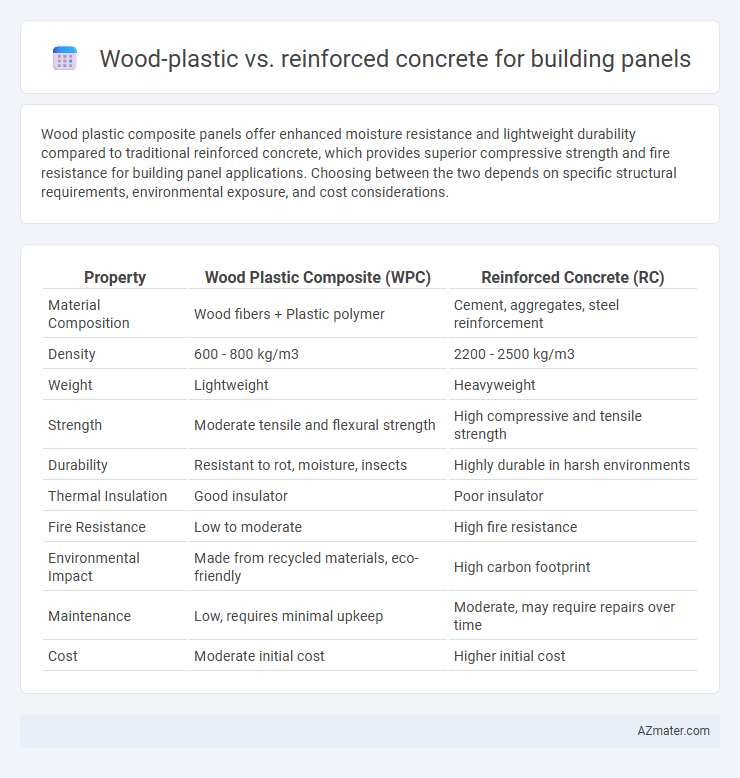Wood plastic composite panels offer enhanced moisture resistance and lightweight durability compared to traditional reinforced concrete, which provides superior compressive strength and fire resistance for building panel applications. Choosing between the two depends on specific structural requirements, environmental exposure, and cost considerations.
Table of Comparison
| Property | Wood Plastic Composite (WPC) | Reinforced Concrete (RC) |
|---|---|---|
| Material Composition | Wood fibers + Plastic polymer | Cement, aggregates, steel reinforcement |
| Density | 600 - 800 kg/m3 | 2200 - 2500 kg/m3 |
| Weight | Lightweight | Heavyweight |
| Strength | Moderate tensile and flexural strength | High compressive and tensile strength |
| Durability | Resistant to rot, moisture, insects | Highly durable in harsh environments |
| Thermal Insulation | Good insulator | Poor insulator |
| Fire Resistance | Low to moderate | High fire resistance |
| Environmental Impact | Made from recycled materials, eco-friendly | High carbon footprint |
| Maintenance | Low, requires minimal upkeep | Moderate, may require repairs over time |
| Cost | Moderate initial cost | Higher initial cost |
Introduction to Building Panel Materials
Wood plastic composites (WPC) and reinforced concrete are prominent materials for building panels, each offering distinct structural and environmental advantages. WPC provides lightweight, moisture-resistant properties ideal for cladding and decorative panels, while reinforced concrete delivers superior strength, durability, and load-bearing capacity essential for structural walls and heavy-duty applications. Selecting between wood plastic and reinforced concrete hinges on project requirements, balancing factors like sustainability, cost-efficiency, and mechanical performance.
Overview of Wood Plastic Composites
Wood plastic composites (WPC) consist of wood fibers combined with thermoplastics such as polyethylene, polypropylene, or polyvinyl chloride, offering improved durability and resistance to moisture compared to traditional wood. WPC panels provide a lightweight, low-maintenance alternative to reinforced concrete, featuring enhanced flexibility and ease of installation for diverse building applications. These composites exhibit high resistance to rot, corrosion, and insect damage, making them suitable for both interior and exterior construction panels.
What is Reinforced Concrete?
Reinforced concrete is a composite material consisting of concrete embedded with steel reinforcement bars, or rebar, to enhance its tensile strength and durability in building panels. This combination provides superior load-bearing capacity and resistance to cracking compared to traditional concrete alone, making it ideal for structural applications. In contrast, wood plastic composites offer lightweight, corrosion-resistant alternatives but lack the high compressive strength and fire resistance of reinforced concrete.
Strength and Durability Comparison
Wood plastic composites (WPC) offer moderate strength and superior resistance to moisture, rot, and insect damage compared to reinforced concrete, making them ideal for environments with fluctuating humidity. Reinforced concrete panels excel in compressive strength, load-bearing capacity, and long-term durability under heavy structural loads, outperforming WPC in terms of impact resistance and fire resistance. The choice between WPC and reinforced concrete for building panels depends on specific project requirements related to structural demands, environmental exposure, and maintenance considerations.
Environmental Impact and Sustainability
Wood plastic composite (WPC) panels offer a lower carbon footprint and reduced resource depletion compared to reinforced concrete, as they leverage recycled plastics and renewable wood fibers. Reinforced concrete panels require significant energy consumption and emit high levels of CO2 during cement production and curing, contributing to environmental degradation. WPC panels also provide improved biodegradability and potential for recycling, enhancing long-term sustainability in building applications.
Cost Analysis: Wood Plastic vs Reinforced Concrete
Wood plastic composite panels generally offer lower initial material and installation costs compared to reinforced concrete panels, making them a cost-effective option for lightweight building applications. Reinforced concrete panels, while having higher upfront expenses due to material, labor, and curing time, provide superior durability, load-bearing capacity, and long-term maintenance savings. Life-cycle cost analysis often favors reinforced concrete in projects requiring high structural integrity, whereas wood plastic composites are preferred for budget-sensitive and rapid construction scenarios.
Installation and Maintenance Considerations
Wood plastic composite (WPC) panels offer easier installation with lightweight properties and the ability to be cut and drilled using standard woodworking tools, reducing labor time and costs compared to the heavier reinforced concrete panels that require specialized equipment for handling and curing. Maintenance of WPC panels involves resistance to rot, insects, and moisture, significantly lowering long-term upkeep compared to reinforced concrete, which demands regular inspection for cracking, surface spalling, and potential rebar corrosion due to environmental exposure. Choosing between these materials depends on balancing the simpler, low-maintenance nature of WPC against the structural durability and fire resistance inherent to reinforced concrete panels.
Thermal and Acoustic Performance
Wood plastic composite panels offer superior thermal insulation due to their low thermal conductivity, reducing energy consumption in buildings. Reinforced concrete panels excel in acoustic performance by providing high mass and density, effectively attenuating sound transmission in noisy environments. Choosing between the two depends on prioritizing insulation efficiency or soundproofing needs for the building project.
Design Flexibility and Aesthetics
Wood plastic composites offer superior design flexibility for building panels due to their ability to be molded into intricate shapes and customized textures, enhancing architectural creativity. Reinforced concrete panels, while durable and structurally robust, tend to have limited aesthetic variations and require additional treatments to achieve diverse finishes. The lightweight nature and customizable surface options of wood plastic panels make them a preferred choice for projects emphasizing both innovative design and visual appeal.
Conclusion: Choosing the Right Building Panel Material
Wood plastic composite panels offer lightweight, moisture resistance, and ease of installation, making them ideal for areas requiring flexibility and reduced environmental impact. Reinforced concrete panels provide superior structural strength, fire resistance, and durability, suited for load-bearing applications and long-term resilience. Selecting between wood plastic and reinforced concrete panels depends on project demands, balancing factors like strength requirements, environmental conditions, cost efficiency, and sustainability goals.

Infographic: Wood plastic vs Reinforced concrete for Building panel
 azmater.com
azmater.com